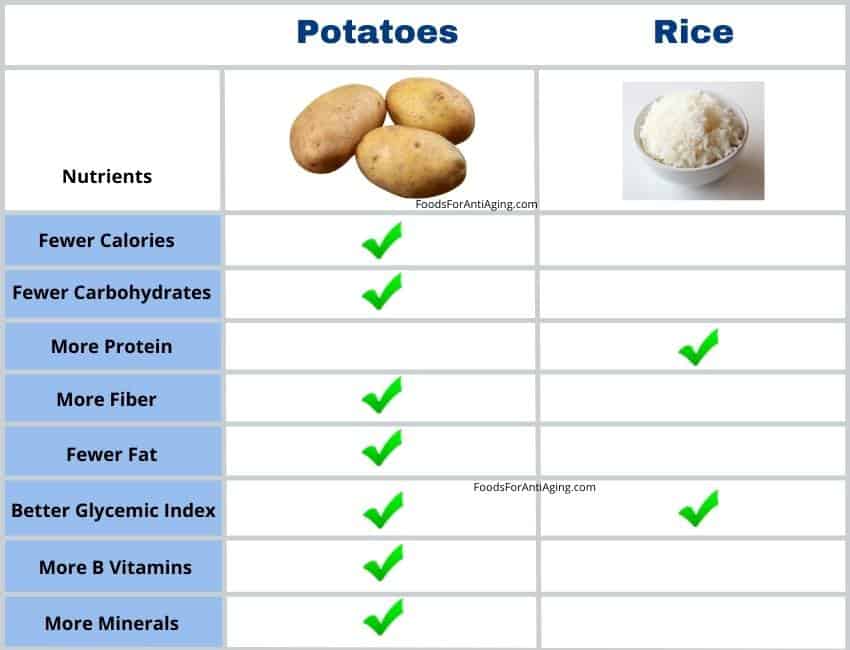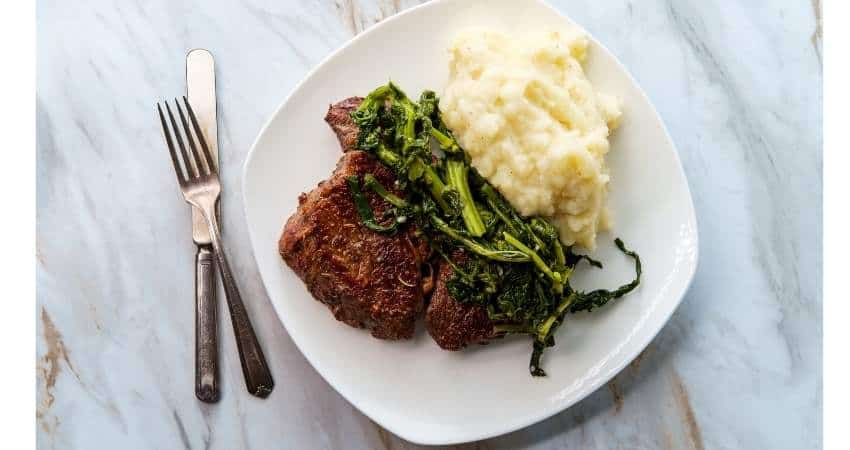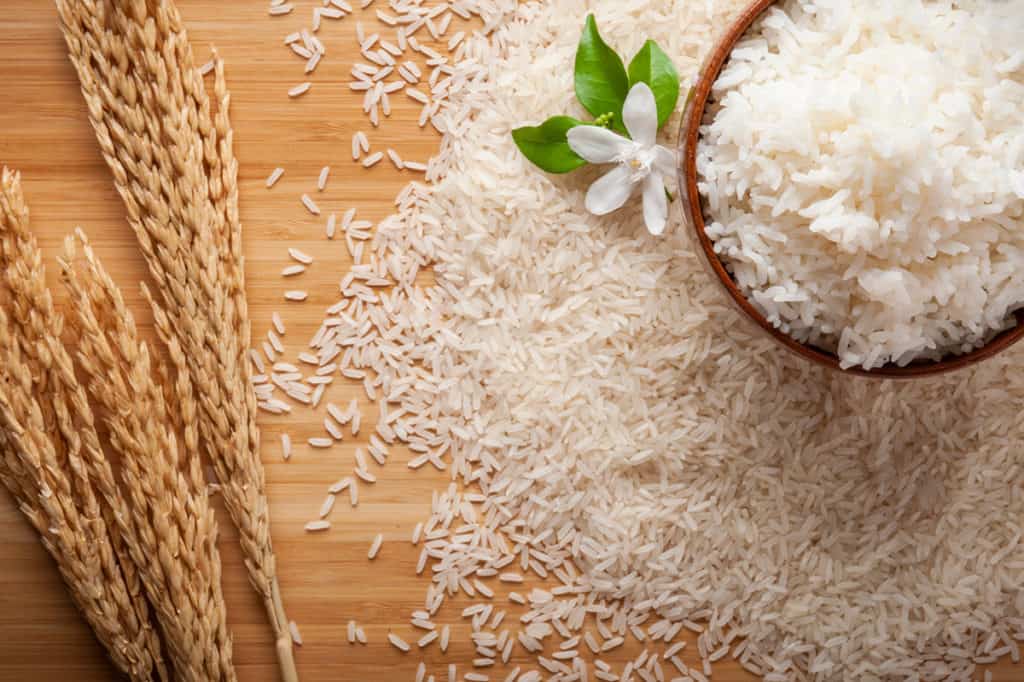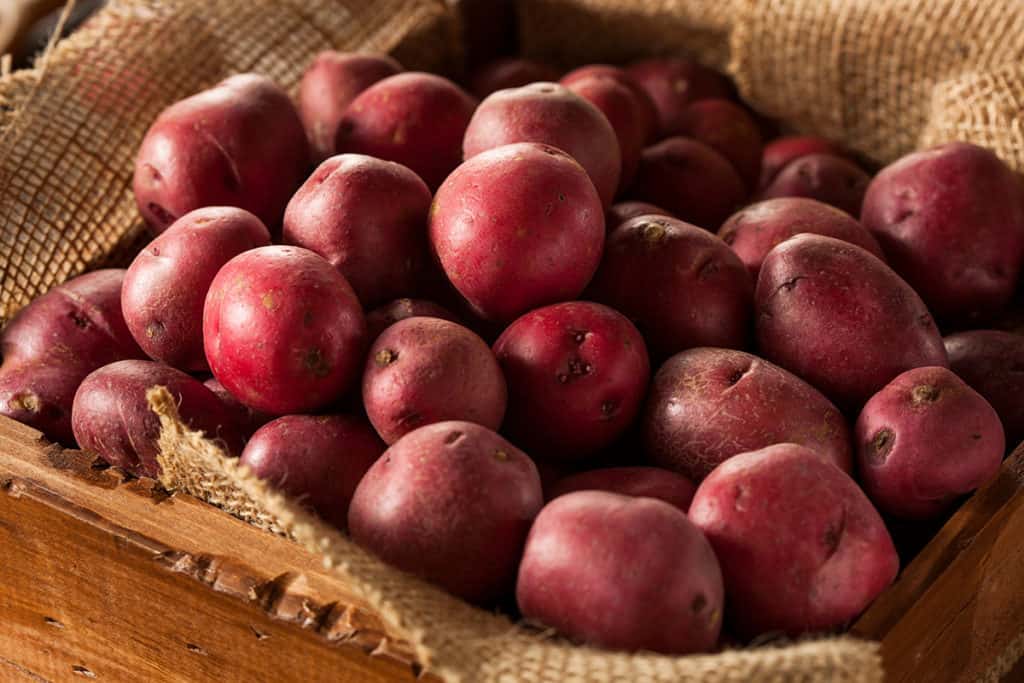Potato vs. Rice Nutrition: Is Potatoes Better Than Rice?
Potato and rice are staple foods consumed every day. As a Certified Health Coach who specializes in nutrition, many of my clients ask about their nutrients. Which leads to the question, are potatoes or rice healthier?
Potato is healthier than rice due to its higher percentage of vitamins, minerals and fiber. The added nutrients help benefit the heart, digestion, gut and the immune system. Potato has fewer calories and carbohydrates than rice better for weight loss.
This article will include a side-by-side comparison of their nutrients. In addition, the benefits of those nutrients are examined and why each food is better for certain nutritional goals.
I’ve purchased, researched and consumed both of these prior to, during and sometimes after writing this article.
Potato vs Rice: Nutritional Values
Any meaningful discussion about health benefits must start with reviewing nutritional information. Therefore, let’s quickly look at the nutrient content of both foods and use it as a basis for the comparison we’ll be doing later.
Here’s a table of the nutrient contents of a 100-gram (3.5 ounce) serving of baked white potato with skin and cooked rice. The rice is medium grain and white which is unenriched.
| Potato Cooked (100 g) | Rice Cooked (100 g) | |
| Calories | 92 | 130 |
| Protein | 2.1 g | 2.3 g |
| Carbohydrates | 21.1 g | 28.6 g |
| Fiber | 2.1 g | 1.0 g |
| Fat | 0.15 g | 0.21 g |
| Vitamin A | 10 IU | 0 IU |
| Beta-carotene | 6 mcg | 0 mcg |
| Vitamin C | 12.6 mg | 0 mg |
| Vitamin B6 | 0.21 mg | 0.05 mg |
| Vitamin B9 (Folate) | 38 mcg | 2 mcg |
| Vitamin B1 (Thiamin) | 0.04 mg | 0.02 mg |
| Vitamin B2 (Riboflavin) | 0.04 mg | 0.01 mg |
| Vitamin B3 (Niacin) | 1.53 mg | 0.40 mg |
| Vitamin B5 (Pantothenic Acid) | 0.38 mg | 0.41 mg |
| Magnesium | 27 mg | 13 mg |
| Phosphorous | 75 mg | 37 mg |
| Potassium | 544 mg | 29 mg |
| Iron | 0.64 mg | 0.20 mg |
| Copper | 0.12 mg | 0.03 mg |
| Calcium | 10 mg | 3 mg |
| Zinc | 0.3 mg | 0.4 mg |
Both contain a wide variety of nutrients. At first it may be difficult to figure out which one is better than the other. Let’s answer the question, which is better for nutritional value?
Potatoes are better for nutrients than rice due to their higher percentage of vitamins, minerals and fiber. They provide more vitamin A, vitamin C, B6, folate, thiamin, riboflavin, niacin, magnesium, phosphorus, potassium, iron, copper and calcium than rice. Potato contains less calories, carbohydrates and fat.
Rice also contains many of those nutrients but in smaller percentages of the daily recommended values. It contains a little more protein, zinc and B5.
I’ll eat both foods but cook a potato more often, especially at breakfast time. When I do eat rice, I choose brown as much as possible for its better nutrients over white.
Macronutrients
Calories
- Rice has more calories.
Total Fat
- Rice has more fat.
Carbohydrates
- Rice has more carbohydrates.
Protein
- Rice has more protein.
Fiber
- Potato has more fiber.

Potatoes Are Better For Weight Loss
Potatoes contain fewer calories than rice making them a better option if you’re watching your calorie count to lose weight. They also provide more dietary fiber, particularly when consumed without peeling the skin. Dietary fiber helps with weight loss by controlling your appetite5.
When consumed, it absorbs water to make you feel fuller. When you feel fuller, you’re less likely to eat more food.
What all this means is the positive impact on weight loss is twofold:
- They provide fewer calories per serving, helping you stick to your daily calorie limit.
- They make you feel full with a relatively small serving, reducing your chances of snacking on unhealthy foods.
Potatoes are Better for Digestion and Gut Health
Potatoes contain more fiber. Fiber remains in the digestive tract and provides gut related health benefits. Fiber rich diets have been linked to regular bowel movements and a lower risk of colon cancer6.
Find out how plantains compared in taste and texture in my article.
Rice May Be Better For Building Muscle
One of the main rules of bulking up and adding quality muscle is to consume more calories than you burn. Instead of restricting calories to the daily recommended count as you would when trying to get lean, the goal to bulk up would be to exceed that count.
Increasing the calories and carbohydrate consumption is where rice has the advantage over potatoes. If you take a look at the above table, you’ll notice a difference between the carbohydrate content of both foods.
You’ll also notice it has more calories per serving, which further helps with bulking.
Carbs not only increase the calories, but they assist by being the primary fuel source with the following:
- Brain
- Body
- Athletic performance
Healthy carbs provide energy for your workouts and build muscle while optimizing recovery7.
Some other healthy complex carbs include:
- Yams
- Sweet potatoes
- Oatmeal
- Brown rice
Even though both foods contain similar amounts of protein, rice contains a little more. Protein is essential for building and repairing muscle after strenuous weight lifting sessions.
On the days I go to the gym and lift weights, I ‘ll choose brown rice for dinner. Many times I’ll have both that day by eating medium baked potatoes at breakfast.

Vitamins
Vitamin C
- Potato: 12.6 mg
- Rice: 0 mg
Vitamin A
- Potato: 10 IU
- Rice: 0 IU
Find out how taro compared in my article here.
The Immune System
Potatoes provide 12.6 mg of vitamin C compared to o mg for rice per 100 grams cooked. The body can’t make vitamin C, so it must come from the foods ate every day.
Vitamin C has been shown in studies to help with the growth and repair of tissues throughout the body8.
Vitamin C helps heal and repair wounds, maintain healthy bones, skin and cartilage.
Vitamin C acts as an antioxidant and fights free radicals which damage the cells. Helping to prevent cell damage can help with the following:
- Promote healthy aging.
- Certain diseases like cancer.
- Heart disease.
Although vitamin C is widely talked about for the immune system, vitamin A is important also. According to Harvard University, vitamin A is a great source to stimulate healthy white blood cells9. Potatoes provide a little more of this vitamin also.
B Vitamins
Of the six B vitamins listed below, potatoes contain more than five of them. The B vitamins provided include the following:
- B1 (thiamin)
- B2 (riboflavin)
- B3 (niacin)
- B5 (pantothenic Acid)
- B6
- B9 (folate)
B vitamins help support the following:
- Cardiovascular disease.
- Red blood cells.
- Brain function.
- Energy levels.
- Digestion.
- Nerve function.
Find out how bread compared for nutrients and benefits in my comparison article.
Heart Health
Potatoes may benefit the heart in several ways. One reason is due to the vitamin C. This vitamin helps lower blood pressure in individuals with elevated blood pressure levels and those without10.
Vitamin C also helps check several risk factors of heart disease, including the following:
- High levels of bad cholesterol.
- Lower good cholesterol.
- Hypertension
By reducing these risk factors, it may help reduce your chances of developing heart disease. The effectiveness of Vitamin C in reducing the risk of heart disease is well documented in various studies.
For instance, a review of 9 scientific studies with almost 300,000 participants was conducted. They established maintaining a daily consumption of at least 700 mg of vitamin C for ten years lowers the risk of heart disease by 25%11.
As mentioned earlier, B vitamins benefit cardiovascular disease which potatoes contain more of.
Find out how turnips compared in my article.

Minerals
Of the seven minerals listed below, potatoes provide a higher percentage of six of them.
| Potato Cooked (100 g) | Rice Cooked (100 g) | |
| Magnesium | 27 mg | 13 mg |
| Phosphorous | 75 mg | 37 mg |
| Potassium | 544 mg | 29 mg |
| Iron | 0.64 mg | 0.20 mg |
| Copper | 0.12 mg | 0.03 mg |
| Calcium | 10 mg | 3 mg |
| Zinc | 0.3 mg | 0.4 mg |
Maintaining Blood Pressure
Potatoes have a higher percentage of the following nutrients beneficial for blood pressure:
- Potassium
- Magnesium
- Vitamin C
- Calcium
Let’s take a look at each one of these minerals and how they benefit blood pressure. Vitamin C was already discussed earlier.
Potassium
Potatoes provide 544 mg of potassium per 100 grams cooked. Potassium helps the body get rid of excess sodium reducing fluid build-up. These help keep systolic and diastolic blood pressure lower ((American Heart Association: How Potassium Can Help Control High Blood Pressure)).
According to Harvard Health, a number of studies have shown a connection between low potassium levels and high blood pressure12. The more potassium, the more sodium your body will lose.
Consuming too much sodium or not enough potassium throws off the delicate balance the kidneys need to remove the excess water13.
Find out how cassava compared in my article here.
Magnesium
Potatoes provide 27 mg of magnesium per 100 grams cooked. Magnesium helps keep blood pressure levels stable and balanced.
A recent study researched previous studies and concluded magnesium supplementation decreased systolic and diastolic blood pressure14.
Magnesium helps control the following:
- Blood pressure
- Blood sugar
- Insomnia
- Nerve function
- Muscle function
Magnesium Tips:
One reason many people supplement with magnesium in the evening is because it helps calm the whole body including blood vessels. In the heart and muscles, magnesium competes with calcium to help the muscles relax after contracting.
When the body is low in magnesium, calcium can over stimulate the heart muscle’s cells causing a rapid or irregular heartbeat ((National Institutes of Health: Magnesium)).
If you’re interested about how sweet spuds held up against pumpkin for health and nutrition, check out my article.
Calcium
Potatoes provide 10 grams of calcium and rice 3 mg per 100 grams cooked. Calcium is important for the heart and blood pressure.
Harvard Health reports calcium helps maintain blood pressure by helping in the controlling of the relaxing and tightening of blood vessels15.
Calcium also helps the following:
- Helps muscles function properly.
- Improve nerve function.
- Build and maintain strong bones.
Phosphorus
Potatoes provide 75 mg of phosphorus and rice 37 mg per 100 grams. Phosphorus has been shown in scientific studies to help with the following:
- Help the body store and manage energy.
- Help the kidneys remove waste.
- Muscle contraction.
- Muscle recovery.
- Promote healthy nerve conduction.
- Promote teeth and bone strength.
Keep Them More Nutrient Dense
If you compare the nutrients of standard baked or boiled potatoes with skin against cooked white rice, potatoes win almost every time. Rice has more calories and significantly fewer micronutrients. Although many people eat rice as a plain side dish, the same can’t be said for potatoes.
People love adding the following to potatoes:
- Sour cream
- Gravy
- Bacon bits
- Butter
Some of these toppings are extremely calorie dense and not very healthy. The healthier potato can quickly become unhealthier. Adding just a little butter into mashed potatoes or on top of a baked potato will add over 100 calories16.
Of course, the same can be said for rice. But most people eat it plain with spices like salt, black pepper, garlic powder and cumin. When adding these delicious spices, you’re actually making it healthier.
So, if you want to get the most out of either carb, steer clear of unhealthy toppings and replace them with herbs and spices.
Find out if Idaho and Russet are really the same in my comparison article.
Is Brown Rice the Healthiest Rice Variety?
The healthiest rice variety is black rice. It is rich in antioxidants, which give it a dark, distinctive color. Dark rice is followed by brown, red and wild rice. All these varieties contain more micronutrients like magnesium, fiber and anthocyanins.
I’ve purposefully selected white potatoes and white rice for the comparison above. Those two are by far the most popular.However, it’s a well-known fact that whole grains are more nutritious. Brown rice is just like white rice, but the bran and germ are left intact.
It contains more fiber, B vitamins, magnesium, phosphorus and other micronutrients than white rice17.
Black rice is arguably healthier, on a different level, because of the high amounts of anthocyanins. They have cancer-fighting properties and may improve your cardiovascular health.
What’s the Healthiest Potato Variety?
The healthiest potato variety is red potato. They have more vitamin C and a higher percentage of B vitamins, fiber and minerals compared to other types. In addition, they contain less calories and carbohydrates than other varieties.

When it comes to nutrition, red potatoes are slightly healthier than the rest. They are high in quercetin, which has proven cancer-fighting properties. This doesn’t mean that other types aren’t good for you.
Unlike rice, there’s no reason to pick one potato type over another just because of nutrition. Instead, get the one that you like the most. The only major change in nutrition is eating them with or without skin, no matter which type. The skin is high in dietary fiber, protein, potassium, phosphorus, vitamin C, B vitamins and magnesium.
By skipping the skin, you’re missing out on gut-healthy fiber and stress-reducing vitamin B.
Find out how red compared to Russet in my article here.
Glycemic Index
Knowing the glycemic index of food is important especially if blood sugar levels are a concern. Avoiding blood sugar spikes is an important thing people should be aware of, diabetic or not.
The Glycemic Index (GI) is a scale measuring how fast a particular food raises the blood sugar in the blood18.
Blood sugar spikes can lead to health complications with the kidneys, nerves, heart and eyes19.
Foods on the GI scale are categorized as:
- Low-GI foods: 55 or under
- Medium-GI foods: 56-69
- High-GI foods: 70 or over
How blood sugars levels are affected:
- Foods with a glycemic index 70 or more cause a quicker spike in blood sugar levels.
- Foods with a glycemic index 56 to 69 cause a moderate spike in blood sugar levels.
- Foods with a glycemic index 55 or less cause a slow spike in blood sugar levels.
Now we know what GI is, and how it affects blood sugar, let’s explore which one has a higher glycemic index.
Potatoes and rice have a similar glycemic index depending on the variety and cooking method used. A boiled Yukon Gold potato has a GI of 58 and white rice has a glycemic index of 64.
- A boiled red potato has a GI of 89.
- A boiled Russet potato has a GI of 54.
- A medium sized white potato has a glycemic index of 50.
Not every white potato or rice has an equal GI. Different varieties all have different GI scores. In addition to how a potato is cooked, the heat of the potato when eaten affects the GI.
A study published in the Journal of the Diabetic Association found boiled potatoes eaten cold had a GI score of 56. When eaten hot they had a GI score of 8920.
Read Next – More Food Articles!
Brown Rice vs White Rice: Which is Better? Let’s Compare
Couscous vs Rice vs Quinoa: Which is Better? Let’s Compare
Red Potatoes vs Yukon Gold Potatoes: What’s The Difference?
Sweet Potato vs. Butternut Squash: A Comparison
Are Sweet Potatoes Healthier Than Regular Potatoes?
Sweet Potato vs. Russet Potato: What’s The Difference?
Yukon Gold Potato vs Russet Potato: What’s The Difference?
- USDA: Potatoes, white, flesh and skin, baked [↩]
- USDA: Rice, medium-grain, cooked, unenriched [↩]
- USDA: Rice, white, short-grain, cooked, unenriched [↩]
- USDA: Rice, white, long-grain, parboiled, unenriched, cooked [↩]
- National Center for Biotechnology Information: The effect of fiber on satiety and food intake: a systematic review [↩]
- National Center for Biotechnology Information: Mechanisms linking dietary fiber, gut microbiota and colon cancer prevention [↩]
- National Center for Biotechnology Information: High-Quality Carbohydrates and Physical Performance [↩]
- National Center for Biotechnology Information: Vitamin C and Immune Function [↩]
- Harvard Health: Vitamin A [↩]
- National Center for Biotechnology Information: Vitamin C lowers blood pressure and alters vascular responsiveness in salt-induced hypertension [↩]
- National Center for Biotechnology Information: Antioxidant vitamins and coronary heart disease risk: a pooled analysis of 9 cohorts [↩]
- Harvard Health: Potassium lowers blood pressure [↩]
- National Center for Biotechnology Information: The Effect of the Sodium to Potassium Ratio on Hypertension Prevalence: A Propensity Score Matching Approach [↩]
- National Center for Biotechnology Information: Effect of magnesium supplementation on blood pressure: a meta-analysis [↩]
- Harvard Health: Key minerals to help control blood pressure [↩]
- USDA: Butter, stick, unsalted [↩]
- USDA: Rice, brown, medium-grain, cooked (Includes foods for USDA’s Food Distribution Program) [↩]
- Harvard Health Publishing: Glycemic index for 60+ foods [↩]
- National Institute of Diabetes and Digestive and Kidney Diseases: Know Your Blood Sugar Numbers: Use Them to Manage Your Diabetes [↩]
- National Center for Biotechnology Information: Glycemic index of potatoes commonly consumed in North America [↩]
